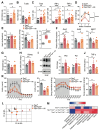T cells with dysfunctional mitochondria induce multimorbidity and premature senescence
- PMID: 32439659
- PMCID: PMC7616968
- DOI: 10.1126/science.aax0860
T cells with dysfunctional mitochondria induce multimorbidity and premature senescence
Abstract
The effect of immunometabolism on age-associated diseases remains uncertain. In this work, we show that T cells with dysfunctional mitochondria owing to mitochondrial transcription factor A (TFAM) deficiency act as accelerators of senescence. In mice, these cells instigate multiple aging-related features, including metabolic, cognitive, physical, and cardiovascular alterations, which together result in premature death. T cell metabolic failure induces the accumulation of circulating cytokines, which resembles the chronic inflammation that is characteristic of aging ("inflammaging"). This cytokine storm itself acts as a systemic inducer of senescence. Blocking tumor necrosis factor-α signaling or preventing senescence with nicotinamide adenine dinucleotide precursors partially rescues premature aging in mice with Tfam-deficient T cells. Thus, T cells can regulate organismal fitness and life span, which highlights the importance of tight immunometabolic control in both aging and the onset of age-associated diseases.
Copyright © 2020 The Authors, some rights reserved; exclusive licensee American Association for the Advancement of Science. No claim to original U.S. Government Works.
Conflict of interest statement
The authors declare no competing interests.
Figures




Comment in
-
Faulty engines in T cells accelerate ageing and disease.Nat Rev Immunol. 2020 Jul;20(7):406-407. doi: 10.1038/s41577-020-0355-9. Nat Rev Immunol. 2020. PMID: 32488202 No abstract available.
-
Dysfunctional T Cell Mitochondria Lead to Premature Aging.Trends Mol Med. 2020 Sep;26(9):799-800. doi: 10.1016/j.molmed.2020.07.001. Epub 2020 Jul 22. Trends Mol Med. 2020. PMID: 32709506
References
-
- Mills EL, Kelly B, O’Neill LAJ. Mitochondria are the powerhouses of immunity. Nat Immunol. 2017;18:488–498. - PubMed
Publication types
MeSH terms
Substances
Grants and funding
LinkOut - more resources
Full Text Sources
Other Literature Sources
Molecular Biology Databases

